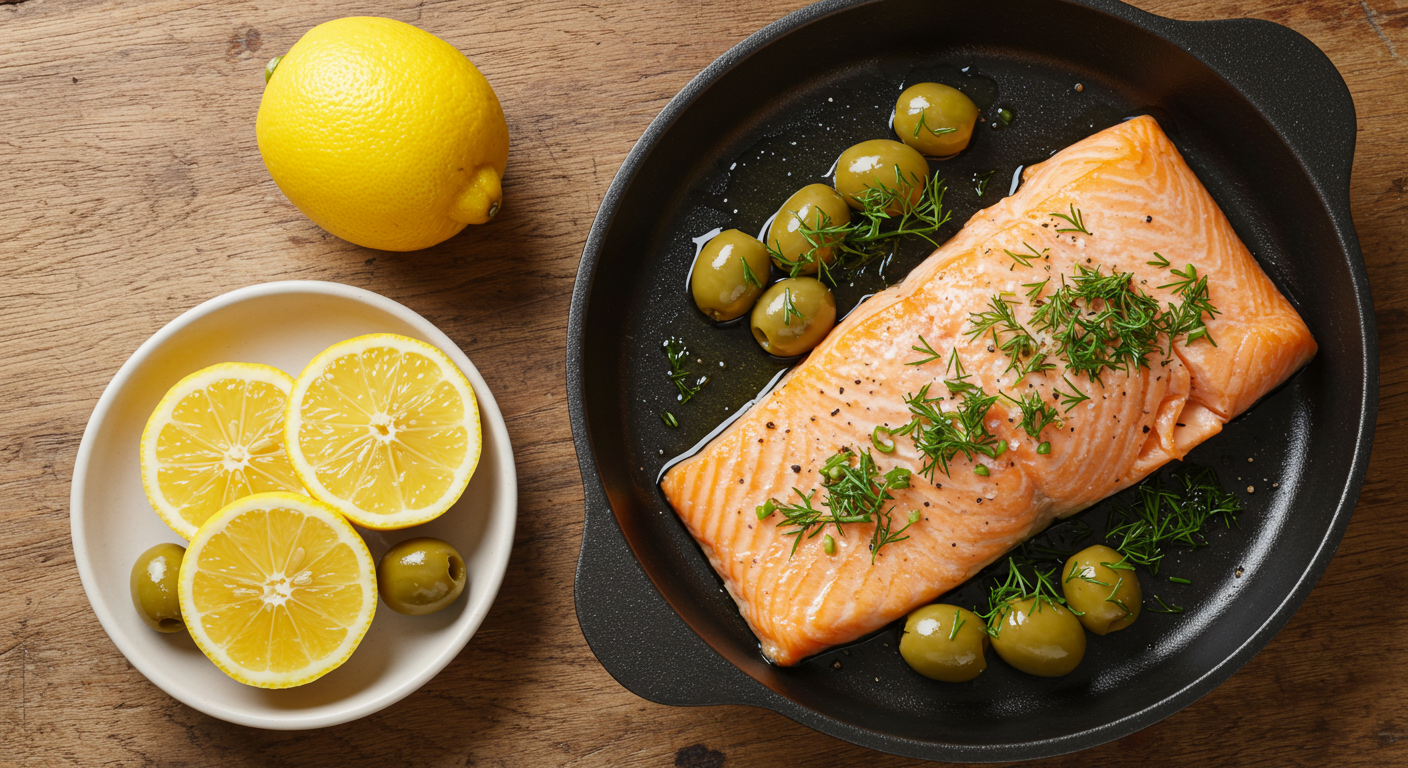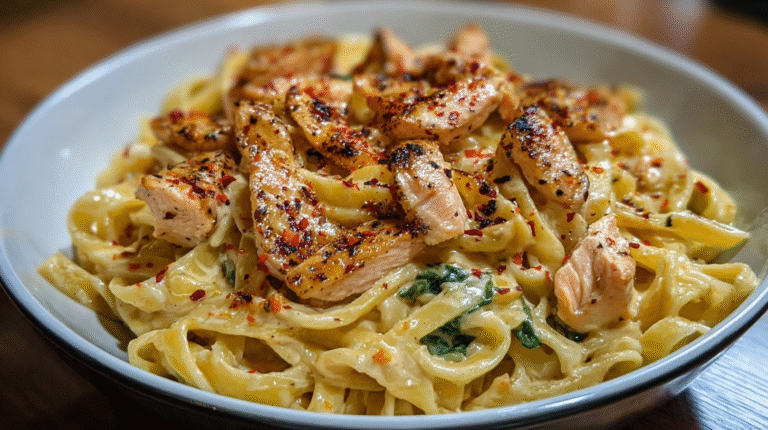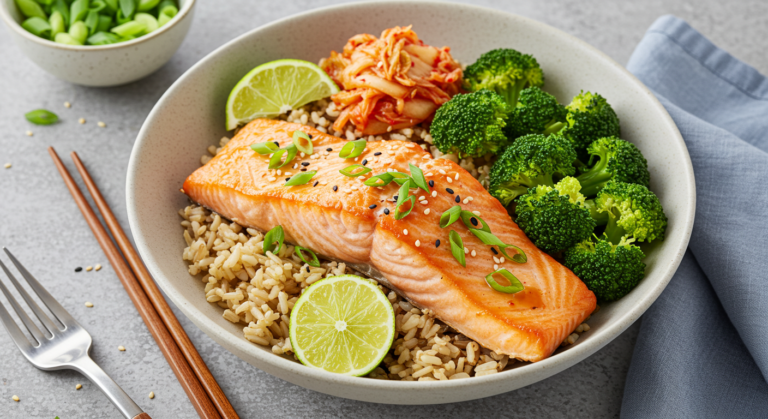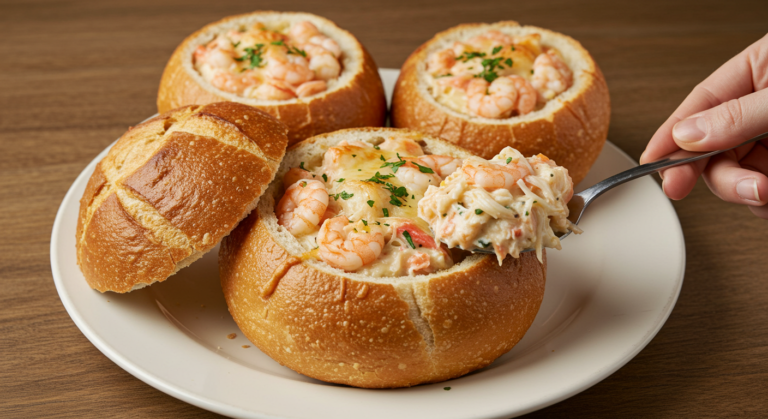Lemon-Roasted Salmon with Green Herb Sauce best A Healthy Dinner Idea
There’s something special about coming home to a homemade meal after a long day. The smell of food cooking fills the house, making it a cozy place. Serving Lemon-Roasted Salmon with Green Herb Sauce is a way to delight your taste buds and nourish your body. It’s perfect for both everyday dinners and special events.
When you cut into the salmon, the lemon and herbs burst with flavor. This dish is not only healthy but also delicious. It shows that you can eat well and stay healthy at the same time.
Table of Contents
Why Choose Salmon for Dinner?
Salmon is a top pick for dinner, known for its health benefits and taste. It’s packed with omega-3 fatty acids, which are good for your heart and reduce inflammation. Plus, it has high-quality protein and low saturated fat, making it great for a healthy diet.
Health Benefits of Salmon
Eating salmon can bring many health perks. It’s full of vitamins D, B12, and selenium. The omega-3s in salmon are great for your heart and brain. This mix of nutrients helps keep your diet balanced and tasty.
Flavor Profile of Salmon
Salmon’s flavor is rich and buttery, perfect for many seasonings and sauces. Its flaky texture makes it even more enjoyable to eat. Whether you add fresh herbs or lemon and garlic, salmon makes any meal special.
A Must-Try: Lemon-Roasted Salmon with Green Herb Sauce
Looking for a culinary delight? Try this Lemon-Roasted Salmon recipe. It’s a mix of simple steps and amazing flavors. The dish has juicy salmon fillets topped with a zesty green herb sauce.
The sauce is made with fresh herbs and lemon. It makes the fish taste even better. This combo is a must-try for anyone who loves great food.
Preparing the dish is easy. Start by letting four 6-ounce salmon fillets get to room temperature. This helps them cook evenly. Then, bake them at 375°F (190°C) for 12 to 15 minutes, depending on their thickness.
It’s important to keep the salmon’s skin on while baking. This keeps the fish moist and tender. You’ll get a delicious result.
This recipe is not only tasty but also healthy. Each serving has about 296 calories and 34 grams of protein. It’s perfect for those watching their diet.
For a fancy touch, add thin lemon slices or a herby drizzle before serving. It looks great and tastes even better.
Ingredients for a Delicious Salmon Dinner
Making a memorable salmon dinner starts with quality ingredients. Knowing what goes into your dish is key. Whether you choose fresh salmon or other seafood, these ingredients make a big difference.
Key Ingredients Overview
For a tasty lemon-roasted salmon, you’ll need:
- 2 lemons, sliced ¼-inch thick
- 1 (2½-pound) skin-on salmon fillet
- 3 cloves garlic, minced
- 5 tablespoons extra-virgin olive oil, divided
- 1 teaspoon salt, divided
- ½ teaspoon ground pepper
- ¾ cup loosely packed fresh flat-leaf parsley
- ¼ cup loosely packed fresh dill
- 2 tablespoons chopped shallots
- 1 tablespoon lemon juice
- 3 pitted green olives
- 1 anchovy fillet, finely chopped
These ingredients boost the flavor and quality of your dish.
Fresh vs. Frozen Salmon
Fresh salmon is the best for taste and texture. Its freshness makes a big difference. If fresh salmon is hard to find, frozen can be a good choice if it’s of high quality. Always check where it comes from for the best quality.
| Ingredient | Quantity | Notes |
|---|---|---|
| Fresh Salmon | 2.5 lbs | Skin-on for optimal moisture |
| Lemons | 2 (zest and juice) | Flavor enhancement |
| Garlic | 3 cloves | Add depth to flavor |
| Olive Oil | 5 tbsp | Extra virgin preferred |
| Fresh Herbs | ¾ cup parsley, ¼ cup dill | Freshness is key |
| Seasonings | Salt, pepper, etc. | To taste |
Step-by-Step Cooking Instructions
This section guides you through making delicious lemon-roasted salmon with a homemade herb sauce. You’ll learn how to prepare the salmon and make a tasty sauce that goes well with it.
Preparation Techniques for Salmon
First, heat your oven to 225°F (107°C) for a gentle roast. Use a sheet pan lined with foil and parchment paper for easy cleanup. Take a 2 lbs (907g) salmon fillet and slice fresh lemons thinly for even cooking.
Season your salmon with ¾ teaspoon of salt, black pepper to taste, and 1 tablespoon of olive oil. Melt butter in a skillet, sauté garlic, and mix in honey and herbs. Pour this flavorful sauce over the salmon fillet.
Preparing the Green Herb Sauce
To make the homemade herb sauce, finely dice 3 tablespoons of shallots and soak them in 3 tablespoons of vinegar. In a bowl, mix 2 tablespoons each of parsley, chervil, chives, basil, and tarragon. Add 5 tablespoons of olive oil and ¼ teaspoon of salt.
Blend all the ingredients and adjust the vinegar to taste for a refreshing flavor. This sauce makes the salmon taste even better and adds a fresh touch to your meal.
After preparing your salmon, bake it at 350°F (175°C) for about 25 minutes. It should reach an internal temperature of 145°F (63°C). For a roasted texture, bake for 40-50 minutes, watching the fillet’s thickness. Follow these steps for a delicious salmon dinner!
Cooking Techniques: Roasting vs. Baking
Understanding the difference between roasting and baking can make a big difference in your salmon dish. Roasting is often better because it caramelizes the outside and keeps the inside moist. This makes the salmon crispy on the outside and juicy on the inside.
Roasting at high temperatures also brings out more flavor. This section will look at why roasting is better and how it differs from baking.
Benefits of Roasting Salmon
Roasting is a great choice for salmon for several reasons:
- Optimal texture: It creates a crispy outer layer.
- Flavor enhancement: High temperatures make flavors more intense.
- Quick cooking time: Salmon roasts in 12-15 minutes, perfect for a quick dinner.
- Easy preparation: Just olive oil, herbs, salt, and pepper make a tasty crust.
Difference Between Roasting and Baking
The main difference between baking and roasting is the temperature and method:
| Aspect | Roasting | Baking |
|---|---|---|
| Temperature | Higher temperatures (typically above 400°F) | Lower temperatures (generally below 400°F) |
| Moisture | Crispier exterior, maintains moisture inside | Typically covered, retains a moist environment |
| Cooking time | 12-15 minutes for salmon fillets | 15 minutes covered, plus additional time uncovered |
| Finishing | Can use a broiler for additional crispness | Often finished with sauces or toppings |
To check if the salmon is done, roast it until it reaches 145°F. But many chefs say it’s best at 135-140°F for the best taste. Whether you choose roasting or baking, knowing the details can make your dinner better.
Perfect Pairings for Your Lemon-Roasted Salmon
Enjoying lemon-roasted salmon is even better with the right side dishes and drinks. Many side dishes for salmon add great flavors that go well with the main dish. These pairings make your dinner more special and memorable.
Best Side Dishes for Salmon
- Orzo salad with lemon and herbs
- Fresh green salad with a light vinaigrette
- Crispy roasted Brussels sprouts
- Herb butter potatoes
- Steamed broccoli with lemon sauce
- Cucumber salad with tangy dressing
- Citrus Brussels sprout slaw
- Kale quinoa salad with lemon
- Garlic green beans
- Crispy sweet potato fries
Drinks that Complement the Meal
Choosing the right drink can really make your meal shine. For lemon-roasted salmon, try these drinks:
- Sauvignon Blanc
- Pinot Grigio
- Dry Rosé
- Light Lager Beer
- Lemon-infused sparkling water
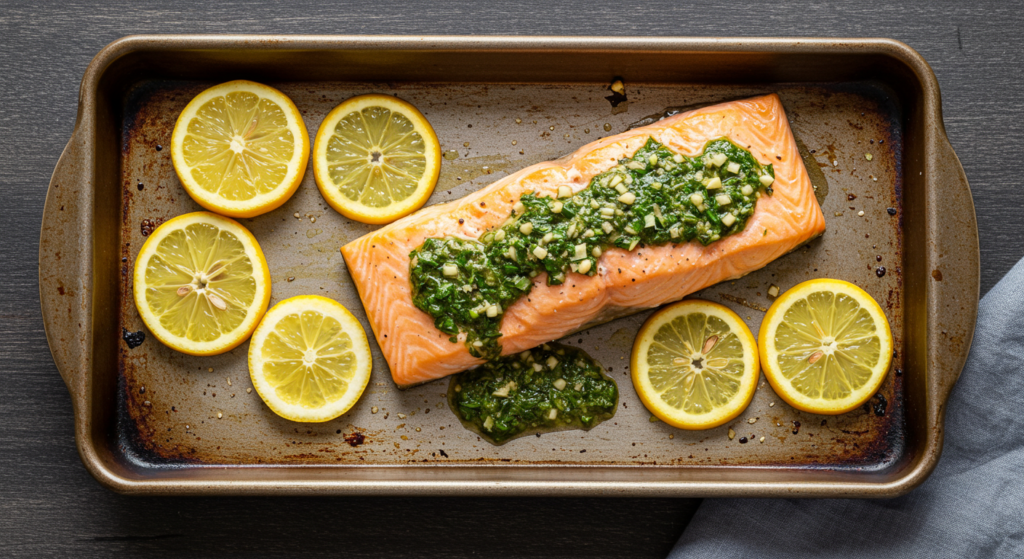
Storing and Reheating Leftover Salmon
Proper handling of leftover salmon ensures you enjoy its taste and nutritional benefits. Cool the leftover seafood quickly and store it in an airtight container. This way, the salmon stays fresh in the fridge for up to three days.
Proper Storage Techniques
To optimize your salmon storage, remember these guidelines:
- Allow the salmon to cool to room temperature before placing it in an airtight container.
- Store the container in the refrigerator, where it can last for three days.
- Label and date your container to ensure you consume the salmon in a timely manner.
Best Methods for Reheating
Reheating leftover salmon properly is key for preserving taste and texture. Here are some reheating tips:
- Place the salmon in an oven-safe dish and bake at 300°F for about 15 minutes.
- Or, reheat salmon gently in the microwave; just be cautious to prevent drying it out.
- For stove-top reheating, use a pan over low heat. Adding a small pat of butter or a squeeze of lemon juice on top before reheating can help keep the salmon moist.
Considerations for Salmon Sourcing
Choosing between wild-caught and farmed salmon is key for taste and ethics. Knowing the differences helps you pick what fits your values and diet. Wild-caught salmon tastes amazing and is healthier than some farmed types. Sustainable farming of salmon can also reduce harm to the environment.
Wild-Caught vs. Farmed Salmon
Wild-caught salmon is known for its great taste and nutrients. It has less fat and more omega-3s, making it a lean choice. Farmed salmon is cheaper and more available, but it’s important to choose it from eco-friendly sources.
Look for certifications like the Marine Stewardship Council (MSC) for wild-caught and Aquaculture Stewardship Council (ASC) for farmed. These labels mean the salmon are caught or farmed responsibly, keeping our oceans safe.
Sustainability Practices in Salmon Fishing
Choosing sustainable salmon helps fight overfishing and damage to habitats. By picking sustainably sourced salmon, you help protect marine life. Many fishing methods focus on keeping salmon populations healthy and reducing harm to other species.
Your salmon choices can shape the industry and help the environment. Choose options that are good for you and the ocean.

Flavor Enhancements and Substitutions
Adding flavor to your lemon-roasted salmon makes it your own. You can try different ingredients to find what you like best. Here are some ideas for your next salmon dinner.
Herb Options to Experiment With
- Fresh dill is a classic choice that goes well with salmon.
- Parsley and chives add freshness and color as garnishes.
- Try herb alternatives like basil and rosemary for a different taste.
Adding lemon slices on top of the salmon while grilling adds a bright flavor. For a richer taste, use herb butter. It adds a deep, aromatic flavor. You can also use lemon zest to make the citrus flavor stronger.
Other ways to enhance flavor include adding garlic for a hint of earthiness. Olive oil is great for cooking and adds flavor. A bit of white wine adds acidity and depth. Smoked paprika adds a smoky sweetness that goes well with the green herb sauce.
This flexibility with flavors makes your lemon-roasted salmon special. It makes every meal unique.
Nutrition Facts of Lemon-Roasted Salmon
Nutritional information is key to understanding the benefits of Lemon-Roasted Salmon. It’s not just tasty, but also packed with nutrients for your health. Each serving of this salmon recipe is a nutritional powerhouse, giving you more than just flavor.
Caloric Content and Macronutrient Breakdown
Looking at salmon calories, it’s important to see the balance of macronutrients. A 6 oz fillet of lemon-roasted salmon has about 308 kcal. It’s a mix of protein, fats, and carbs. Here’s a detailed breakdown:
| Nutrient | Amount per Serving (6 oz) |
|---|---|
| Calories | 308 kcal |
| Protein | 34 g |
| Total Fat | 18 g |
| Saturated Fat | 2 g |
| Cholesterol | 91 mg |
| Carbohydrates | 1 g |
| Dietary Fiber | 0 g |
| Total Sugars | 0 g |
Vitamins and Minerals in Salmon
The vitamins in seafood, like salmon, are plentiful and varied. This dish is a treasure trove of essential vitamins and minerals. Here’s what you’ll find:
- Vitamin A: 345 IU
- Vitamin C: 27.5 mg
- Calcium: 48 mg
- Iron: 2.4 mg
- Potassium: 1183 mg
This profile shows why Lemon-Roasted Salmon is great for your health. It’s a perfect balance of macronutrients and vitamins and minerals. It’s an excellent choice for dinner.
Conclusion
Choosing Lemon-Roasted Salmon with Green Herb Sauce for dinner is a great choice. It’s full of omega-3 fatty acids, which are good for your heart and brain. Plus, it’s quick to make, taking only 15-20 minutes in the oven.
This dish is also very flexible. You can add a spicy kick or a creamy sauce to suit your taste. You can also change up the herbs and ingredients to keep your meals exciting. This makes salmon recipes a great part of a healthy lifestyle.
Lemon-Roasted Salmon is more than just a meal. It’s a chance to enjoy a healthy dish that’s perfect for any time. By trying this recipe, you’ll get delicious flavor and extra nutrients. Start this tasty journey today and improve your cooking skills!
FAQ
What makes lemon-roasted salmon a healthy dinner option?
How do I choose between fresh and frozen salmon?
What are the key ingredients for Lemon-Roasted Salmon?
Can I use different herbs in the green herb sauce?
What are the best side dishes to serve with lemon-roasted salmon?
How should I store leftover salmon?
What is the best method for reheating salmon without drying it out?
What should I know about sustainability when sourcing salmon?
What are the health benefits of incorporating salmon into my diet?
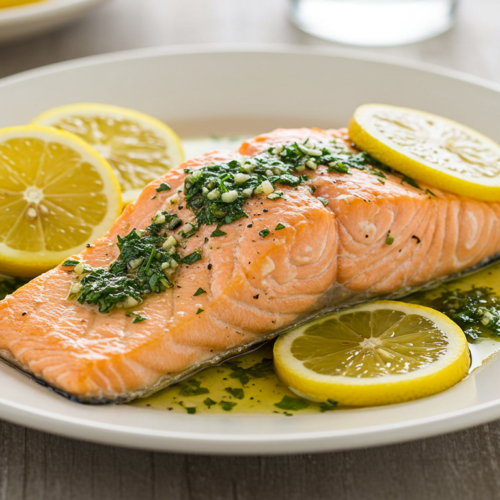
Lemon-Roasted Salmon with Green Herb Sauce
Ingredients
- 2 lemons sliced ¼-inch thick
- 1 2½-pound skin-on salmon fillet
- 3 cloves garlic minced
- 5 tablespoons extra-virgin olive oil divided
- 1 teaspoon salt divided
- ½ teaspoon ground pepper
- ¾ cup loosely packed fresh flat-leaf parsley
- ¼ cup loosely packed fresh dill
- 2 tablespoons chopped shallots
- 1 tablespoon lemon juice
- 3 pitted green olives
- 1 anchovy fillet finely chopped (about ½ teaspoon)
Instructions
- Preheat Oven: Set the oven to broil with the rack in the top third position. Line a large rimmed baking sheet with foil.
- Prepare Salmon: Arrange lemon slices in a single layer on the prepared baking sheet. Place the salmon fillet, skin-side down, on top of the lemon slices.
- – Rub the salmon with minced garlic and 1 tablespoon olive oil. Sprinkle with ½ teaspoon salt and ½ teaspoon pepper. Let it marinate for 10 minutes.
- – Broil for 10 to 12 minutes or until the salmon flakes easily with a fork.
- Make Green Herb Sauce: While the salmon is broiling, combine ¾ cup parsley, ¼ cup dill, 2 tablespoons shallots, 1 tablespoon lemon juice, green olives, chopped anchovy, the remaining 4 tablespoons olive oil, and ½ teaspoon salt in a blender.
- – Process until smooth, 1 to 2 minutes, starting on low speed and gradually increasing to high. Use a tamper if needed to help blend the ingredients.
- Serve: Place the salmon on a large platter and drizzle with the green herb sauce.

